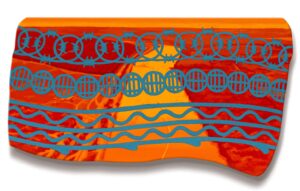Atoyatl – Bravo

Atoyatl – Bravo, 2024, acrylic on canvas over shaped wood panel, 15.5 x 11 inches.
My most recent work combines reinterpretations of pre-Hispanic Mexican codices with sociopolitical American references – as a way to talk about my experience as a Mexican immigrant living in the United States. This painting depicts the Rio Grande in yellow and reds, with the Mexico and US on either side of the border. Over the composition are three different symbols: starting at the bottom is an atoyacoatl (a snake/river) which represent movement, life, and death. Over the atoyacoatl is a reinterpretation of the buoys that were deployed along the Rio Grande by the Texas state government as an effort to deter migrants from crossing, which resulted in several deaths. At the very top, is a line of barbed wire that closes out the composition and echoes the US-Mexico border wall. While the symbolism represents physical barriers that are designed to keep immigrants away from US soil, they also stand in for xenophobia and other ideologies that seek to criminalize immigrants lives and refuse to see their positive contribution to Americas cultural fabric.
Artist Statement: My most recent series of paintings present an opportunity to reflect on my particular experience as a Mexican national living in the United States, and to communicate the distinct cultural, political, and economic space I occupies as an immigrant. My acrylic on shaped canvas and site-specific paintings are indicative of a form of knowledge that symbolic, intuitive, poetic, and transcends rationalism. LONG VERSION: My work is a reflection of cultural, political, and economic forces that define the contours of my experience as a Mexican immigrant in the United States. The paintings bring together elements of pre- and early colonial Mexican art, with references to contemporary American culture and politics. This interpretive process is guided by the continual reflection on my personal experience as a Mexican immigrant. It is also characterized by the desire to contextualize my position within the broader history and politics of Latin immigration to the United States. The deviation from natural local color in each painting is suggestive of a heightened visual experience, or a moment of ecstasy. This is indicative of a form of thinking that is symbolic, intuitive, poetic, and that transcends rationalism. Unconfined by aspects of the Western painting tradition, each work on canvas stretches over irregular wooden supports. By loosely alluding to archeological findings, they suggest their presence as a fragment of an unknown whole. This gives an opportunity for the viewer to expand the narrative, based on their own experience, by imagining the missing context.



